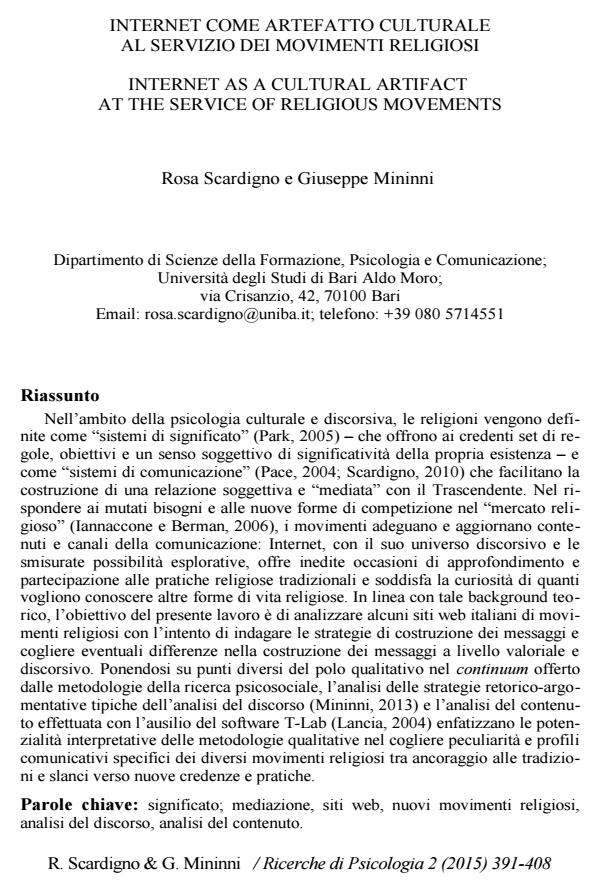Internet as a cultural artifact at the service of religious movements
Journal title RICERCHE DI PSICOLOGIA
Author/s Rosa Scardigno, Giuseppe Mininni
Publishing Year 2015 Issue 2015/2
Language Italian Pages 18 P. 391-408 File size 192 KB
DOI 10.3280/RIP2015-002008
DOI is like a bar code for intellectual property: to have more infomation
click here
Below, you can see the article first page
If you want to buy this article in PDF format, you can do it, following the instructions to buy download credits

FrancoAngeli is member of Publishers International Linking Association, Inc (PILA), a not-for-profit association which run the CrossRef service enabling links to and from online scholarly content.
In the perspective of cultural and discursive psychology, religions can be defined as "systems of meaning" (Park, 2005) - that offer to believers sets of beliefs, aims and a subjective feeling of meaningfulness - and as "systems of communication" (Pace, 2004; Scardigno, 2010), that facilitate the construction of a subjective and "mediated" relation with the Transcendent. In the efforts to answer to the changed needs and to the new forms of competitions of the "religious market" (Iannaccone e Berman, 2006), religious movements adapt and update their contents and channels of communication: Internet, through its discursive universe and its limitless explorative possibilities, offers unprecedented chances of deepening and participation to the traditional religious practices and satisfies those who want to meet other religious forms of life. In accordance with this theoretical background, the aim of the present work is to analyze some Italian websites of religious movements in order to investigate the strategies of construction of messages and to catch eventual differences to both value and discursive level. Working on different levels of the qualitative pole in the continuum offered by methodologies in psychosocial research, the analysis of the rhetoric-argumentative strategies typical of discourse analysis (Mininni, 2013) and the content analysis made through the software T-Lab (Lancia, 2004) emphasize the interpretative possibilities of the qualitative methods to gain the peculiarities and the specific communicative profiles of the different religious movements by anchoring to the tradition and, on the other side, by giving impulse to new beliefs and practices.
Keywords: Meaning; mediation, websites, new religious movements, discourse analysis, content analysis.
Rosa Scardigno, Giuseppe Mininni, Internet come artefatto culturale al servizio dei movimenti religiosi in "RICERCHE DI PSICOLOGIA " 2/2015, pp 391-408, DOI: 10.3280/RIP2015-002008